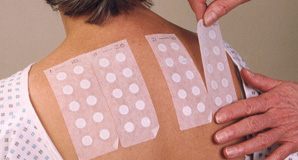Allergy Patch Tests
Who needs Patch Tests?
These tests are frequently ordered by skin specialists where there is a suspicion of contact dermatitis, irritant dermatitis or occupational dermatitis. The skin condition needs to be under control and steroid creams should not be used for 3-4 weeks before the test.
Patch tests are another form of allergy test. They differ in that they test for delayed hypersensitivity (Type IV reaction). This reaction takes two to three days to develop. Unlike the other types, it is not antibody mediated but rather is a type of cell-mediated response. CD8 cytotoxic T cells and CD4 helper T cells recognise antigen in a complex with either type 1 or 2 major histocompatibility complex. The antigen-presenting cells in this case are macrophages and they release interleukin 1, which stimulates the proliferation of further CD4 cells. These cells release interleukin 2, further inducing the release of other Type 1 cytokines, thus mediating the immune response. Activated CD8 cells destroy target cells on contact while activated macrophages produce hydrolytic enzymes and, on presentation with certain intracellular pathogens, transform into multinucleated giant cells.
How are Patch Tests performed?
The allergens are prepared in appropriate concentrations in soft white paraffin. They are then placed onto metal discs of 1 cm diameter. The discs are are taped on the back and left for 48-72 hours. Both the discs and the tape are made of hypoallergenic material. Disks are then removed and the skin is examined for redness and swelling.
A final reading by a specialist familiar with the patients clinical problem is required after a further 48 hours. The patient must desist from bathing for several days during the period of the test. Patients are tested for ingredients in many commonly used everyday materials.
Standard series, metals, rubber, cosmetic, preservatives, pharmaceuticals and miscellaneous panels:
Figure shows metal discs taped to the skin on the back.
What are the side effects?
Recognised complications of patch testing include irritant reactions causing burns and scarring, allergic sensitization to the allergen being tested, localised flare of dermatitis, flare of dermatitis at previous contact sites, depigmentation (loss of skin pigment) or pigmentation (excessive pigment) around the site of testing and urticarial reactions (hives). Generally the risks of patch testing are minimal when performed correctly by experienced personnel.
Cost?
Patch testing is normally arranged by a dermatologist. Initial fee is paid to the consultant followed by a visit to the allergy laboratory for a patch test.
Cost of Patch Testing—-€220 for two visits to the Laboratory.

